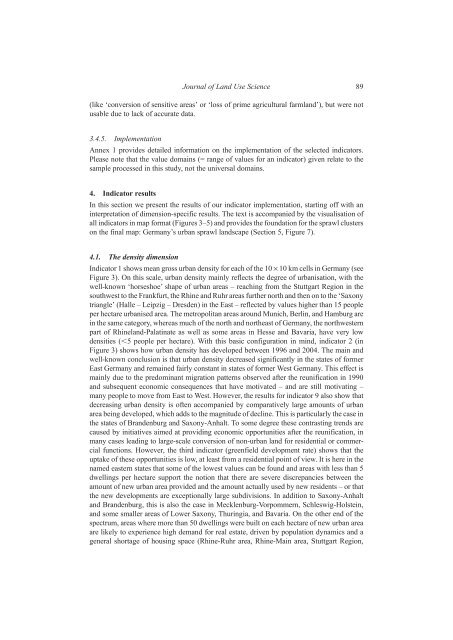PDF 20.134kB - TOBIAS-lib - Universität Tübingen
PDF 20.134kB - TOBIAS-lib - Universität Tübingen
PDF 20.134kB - TOBIAS-lib - Universität Tübingen
Erfolgreiche ePaper selbst erstellen
Machen Sie aus Ihren PDF Publikationen ein blätterbares Flipbook mit unserer einzigartigen Google optimierten e-Paper Software.
Journal of Land Use Science 89<br />
(like ‘conversion of sensitive areas’ or ‘loss of prime agricultural farmland’), but were not<br />
usable due to lack of accurate data.<br />
3.4.5. Implementation<br />
Annex 1 provides detailed information on the implementation of the selected indicators.<br />
Please note that the value domains (= range of values for an indicator) given relate to the<br />
sample processed in this study, not the universal domains.<br />
4. Indicator results<br />
In this section we present the results of our indicator implementation, starting off with an<br />
interpretation of dimension-specific results. The text is accompanied by the visualisation of<br />
all indicators in map format (Figures 3–5) and provides the foundation for the sprawl clusters<br />
on the final map: Germany’s urban sprawl landscape (Section 5, Figure 7).<br />
4.1. The density dimension<br />
Indicator 1 shows mean gross urban density for each of the 10 · 10 km cells in Germany (see<br />
Figure 3). On this scale, urban density mainly reflects the degree of urbanisation, with the<br />
well-known ‘horseshoe’ shape of urban areas – reaching from the Stuttgart Region in the<br />
southwest to the Frankfurt, the Rhine and Ruhr areas further north and then on to the ‘Saxony<br />
triangle’ (Halle – Leipzig – Dresden) in the East – reflected by values higher than 15 people<br />
per hectare urbanised area. The metropolitan areas around Munich, Berlin, and Hamburg are<br />
in the same category, whereas much of the north and northeast of Germany, the northwestern<br />
part of Rhineland-Palatinate as well as some areas in Hesse and Bavaria, have very low<br />
densities (,5 people per hectare). With this basic configuration in mind, indicator 2 (in<br />
Figure 3) shows how urban density has developed between 1996 and 2004. The main and<br />
well-known conclusion is that urban density decreased significantly in the states of former<br />
East Germany and remained fairly constant in states of former West Germany. This effect is<br />
mainly due to the predominant migration patterns observed after the reunification in 1990<br />
and subsequent economic consequences that have motivated – and are still motivating –<br />
many people to move from East to West. However, the results for indicator 9 also show that<br />
decreasing urban density is often accompanied by comparatively large amounts of urban<br />
area being developed, which adds to the magnitude of decline. This is particularly the case in<br />
the states of Brandenburg and Saxony-Anhalt. To some degree these contrasting trends are<br />
caused by initiatives aimed at providing economic opportunities after the reunification, in<br />
many cases leading to large-scale conversion of non-urban land for residential or commercial<br />
functions. However, the third indicator (greenfield development rate) shows that the<br />
uptake of these opportunities is low, at least from a residential point of view. It is here in the<br />
named eastern states that some of the lowest values can be found and areas with less than 5<br />
dwellings per hectare support the notion that there are severe discrepancies between the<br />
amount of new urban area provided and the amount actually used by new residents – or that<br />
the new developments are exceptionally large subdivisions. In addition to Saxony-Anhalt<br />
and Brandenburg, this is also the case in Mecklenburg-Vorpommern, Schleswig-Holstein,<br />
and some smaller areas of Lower Saxony, Thuringia, and Bavaria. On the other end of the<br />
spectrum, areas where more than 50 dwellings were built on each hectare of new urban area<br />
are likely to experience high demand for real estate, driven by population dynamics and a<br />
general shortage of housing space (Rhine-Ruhr area, Rhine-Main area, Stuttgart Region,

















